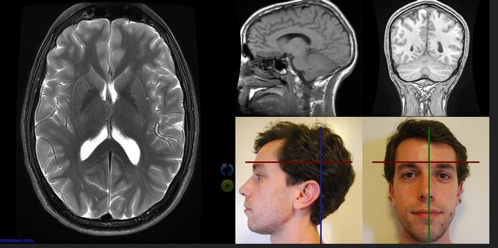A man posts an interactive browser of his brain (scan).
 Thursday, September 24, 2009 at 8:54PM
Thursday, September 24, 2009 at 8:54PM I spent quite a lot of time working with Magnetic Resonance Imaging (MRI) scans during my doctoral research. In my case I looked at two specific things. The MRI is very helpful when one wishes to establish the location of some form of damage to the brain (a tumor, cyst, or lesion). I used this to help me understand how persons processed meaning (and of course how pathology impacted the processing of meaning in the human brain - it is a common occurrence that persons manifest heightened religious or spiritual consciousness when they have some form of abnormality in their brain). Just as an aside, note that I say abnormality in this instance and not pathology! Of course this is because being different from the norm is not only a neurological phenomenon. There are many persons who are different from the norm (whatever the 'norm' is!) because, for example, they may be an immigrant in a new country (sociology), taller than the average population (physical attributes), have extra abilities (such as exceptional sports skills) etc. Abnormality must not be confused with pathology - just because someone, or something, is not 'normal' it does not make it wrong.
Nelson Mandela is an 'abnormal' being - after 27 years in prison the average person (normal) would seek some form of retribution or revenge for their suffering. He, however, sought reconciliation! Abnormality can give us a great deal of insight into how things should be!
Other than MRI scans I also made use of magnetoencephalography - this is different from MRI scanning (well slightly different) in that it gives one the ability to view the whole brain (rather than just 'slices' of the brain) to be able to see where the electrical pulses and 'hotspots' of certain cognitive processes are located. So, for example, one could ask a person to imagine a certain event, or stimulate an emotion through showing them a picture, inducing the sense of smell, or playing a piece of music, and then see where in the brain there is electrical activity (neural activity). I am STILL working on a rewrite of my doctoral thesis - when that project is done it will present some of my research on how the brain processes religious consciousness (particularly as it relates to identity). The working title of the book is "Why you're not who you think you are: Adventures in neuroscience and theology".
Of course the human brain is only one part of the complex array of interconnected elements that makes up who we truly are - however, it is a rather important part of that complex reality! I found the following post quite interesting (if not amusing!). If you're interested to see what an MRI looks like in relation to the person who's brain was scanned then follow this link. Here's the original story from Boing Boing.

For more of my posts on the brain and neuroscience please follow this link, or simply search for 'brain' or 'neuroscience' in the search box on this blog.




